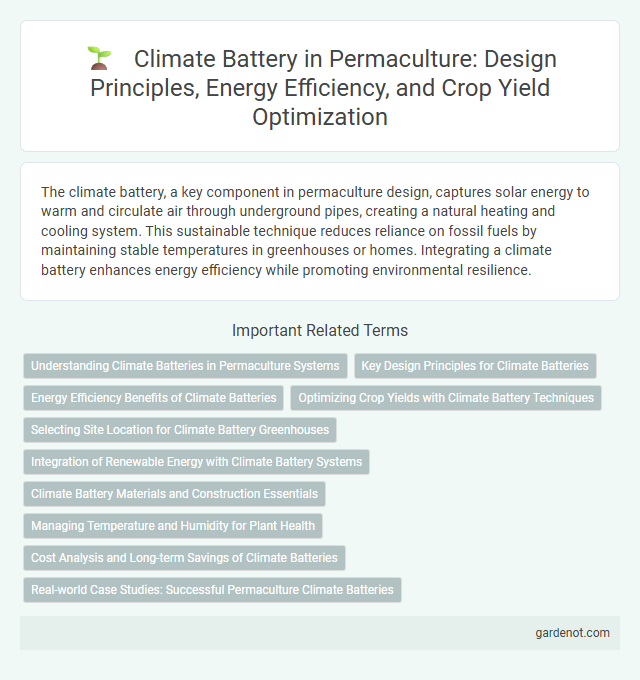The climate battery, a key component in permaculture design, captures solar energy to warm and circulate air through underground pipes, creating a natural heating and cooling system. This sustainable technique reduces reliance on fossil fuels by maintaining stable temperatures in greenhouses or homes. Integrating a climate battery enhances energy efficiency while promoting environmental resilience.
Understanding Climate Batteries in Permaculture Systems
Climate batteries in permaculture systems efficiently harness and store solar energy by circulating air through underground tubes, maintaining stable temperatures for plant growth. This passive heating and cooling technique reduces reliance on fossil fuels while enhancing microclimate regulation and soil health. Integrating climate batteries optimizes energy cycles, promoting sustainable and resilient agricultural practices.
Key Design Principles for Climate Batteries
Climate batteries leverage thermal mass and earth insulation to store and redistribute heat efficiently within a permaculture system. Key design principles include maximizing surface area between the thermal mass and airflow, maintaining airtight conditions to prevent heat loss, and optimizing subterranean pipe placement for effective heat exchange. Incorporating moisture control and passive solar gain enhances overall energy capture and maintains consistent temperatures.
Energy Efficiency Benefits of Climate Batteries
Climate batteries enhance energy efficiency by utilizing thermal mass and passive solar heating to store and redistribute heat within greenhouse environments. This system reduces reliance on external heating sources, leading to significant energy savings and lower carbon footprints. Optimized airflow and temperature regulation through climate batteries improve plant growth conditions while maintaining sustainable energy consumption.
Optimizing Crop Yields with Climate Battery Techniques
Climate battery systems use underground heat storage to regulate temperature and humidity within permaculture greenhouses, creating ideal microclimates that extend growing seasons and boost crop yields. By circulating warm air through subterranean pipes, these techniques reduce energy consumption and improve plant growth consistency, especially in cooler climates. Implementing climate battery technology enhances soil moisture retention and nutrient availability, optimizing conditions for diverse, high-yield crops year-round.
Selecting Site Location for Climate Battery Greenhouses
Selecting an optimal site location for climate battery greenhouses involves analyzing solar exposure, wind patterns, and soil depth to maximize heat capture and retention. Ideal locations have consistent sunlight throughout the day, natural windbreaks, and well-drained soil with adequate organic matter to enhance thermal mass. Careful assessment of these factors improves energy efficiency, supports plant growth, and reduces dependency on supplemental heating.
Integration of Renewable Energy with Climate Battery Systems
Climate battery systems leverage subterranean thermal storage to regulate greenhouse temperatures efficiently. Integrating renewable energy sources such as solar panels and wind turbines enhances this system's performance by providing sustainable, off-grid power for air circulation and monitoring technologies. This synergy reduces fossil fuel dependency, optimizes energy use in permaculture setups, and supports year-round plant growth within controlled microclimates.
Climate Battery Materials and Construction Essentials
Climate batteries optimize passive heating and cooling by circulating air through underground pipes made of durable materials like PVC or polyethylene. Effective insulation with recycled cellulose or foam boards and a well-sealed greenhouse structure are critical to maintaining thermal efficiency. Proper sizing, orientation, and airtight construction ensure maximum heat exchange and energy conservation in permaculture systems.
Managing Temperature and Humidity for Plant Health
A climate battery effectively manages temperature and humidity by circulating warm, moist air through underground pipes, stabilizing plant environments in permaculture systems. This thermal regulation reduces stress on plants, promotes consistent growth, and minimizes the risk of fungal diseases caused by excessive moisture. Integrating a climate battery maximizes energy efficiency while maintaining optimal microclimates for diverse plant species.
Cost Analysis and Long-term Savings of Climate Batteries
Climate batteries, also known as subterranean heating and cooling systems, leverage earth's natural thermal mass to regulate greenhouse temperatures efficiently, significantly reducing reliance on conventional heating and cooling systems. Initial installation costs vary widely, typically ranging between $5,000 and $15,000, depending on system size and soil conditions, but long-term savings on energy bills can reach 40-60%, making them cost-effective over a 10-15 year period. Maintenance expenses for climate batteries remain low compared to HVAC systems, enhancing their economic viability and sustainability in permaculture setups.
Real-world Case Studies: Successful Permaculture Climate Batteries
Permaculture climate batteries have demonstrated significant success in various real-world case studies, such as at the Zaytuna Farm in Australia, where underground thermal mass systems maintain stable soil temperatures year-round. These installations optimize passive solar energy to enhance microclimates, improving crop yields while reducing reliance on external energy inputs. Evidence from multiple farms confirms climate batteries effectively extend growing seasons and increase resilience against extreme weather events.
Climate battery Infographic

 gardenot.com
gardenot.com